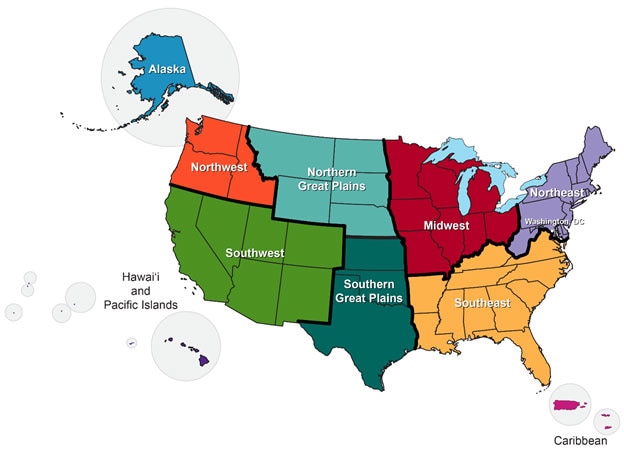Welcome to the sixth edition of the Climate and Health Outlook from the Department of Health and Human Services (HHS) Office of Climate Change and Health Equity (OCCHE). This Climate and Health Outlook provides a retrospective look at how heat and drought affected the U.S. in the summer of 2022. This webpage includes additional resources and information excluded from the PDF summary, including regional prospective forecasts.
Download the Climate and Health Outlook for November 2022 - January 2023

Image source: https://scenarios.globalchange.gov/regions_nca4
U.S. Seasonal Forecast for Health: November 2022 – January 2023
Regional health forecasts for heat, wildfire, drought, and hurricanes
In the coming months, most of the contiguous U.S. will experience temperatures 0.9 – 3.6 °F (0.5 – 2 °C) warmer than normal. Warming winters can cause earlier and longer allergy seasons, aggravating conditions like allergic asthma. Increasing winter temperatures can also contribute to earlier onset of vector-borne diseases like Lyme disease.
Alaska: Alaska is likely to remain drought-free through the end of January 2023. Normal significant wildland fire potential is also expected.
Northwest: Drought is favored to persist in parts of southern Idaho and Oregon. However, drought improvement and removal is favored in much of the region.
Southwest: Drought is favored to persist in California, Nevada, Utah, and parts of Arizona, New Mexico, and Colorado. However, drought improvement is favored in the northwestern corner of California. Above normal wildland fire* potential is forecast for parts of southern California into November, before returning to normal potential in December.
Hawai’i and Pacific Islands: The Central Pacific is projected to have a below-average hurricane season. Drought improvement and removal is favored in Hawai’i. The Hawai’ian Islands will continue to have above normal wildland fire* potential, especially lee sides, through November before returning to normal potential in December.
Northern Great Plains: Drought is favored to persist or develop in Nebraska. Drought is also favored to persist in parts of Montana, North Dakota, South Dakota, and Wyoming. However, drought improvement and removal is favored in western Montana.
Southern Great Plains: Drought is favored to persist or develop in Kansas, Oklahoma, and Texas. Above normal wildland fire* potential is forecast for much of Oklahoma and Texas into December, before returning to normal potential in January.
Midwest: Drought is favored to persist or develop in Missouri; persist or improve in Minnesota, Illinois, and Kentucky; improve in Michigan, Wisconsin, Indiana, and Ohio; and develop, persist, or improve in Iowa. Above normal wildland fire* potential is likely to continue for southern Missouri through November, before returning to normal in December.
Southeast: The Atlantic basin is forecasted to have an above-average hurricane season with 14 – 20 named storms with winds of 39 mph or higher, with 6 –10 of those possibly becoming hurricanes with winds of 74 mph or higher, and 3 – 5 possibly becoming major hurricanes with winds of 111 mph or higher. Drought is favored to persist or develop in Alabama, Arkansas, Georgia, Louisiana, and Mississippi, and parts of Florida, South Carolina, and Tennessee. Above normal wildland fire* potential is forecast for much of Arkansas, Louisiana, Mississippi, Alabama, and western Tennessee through November, with above normal potential continuing in much of Louisiana and Mississippi into December. Above normal potential is also forecast in western Kentucky during November. The region is forecast to have near normal significant wildland fire* potential during January.
Northeast: Drought improvement and removal is favored along the northeastern seaboard, including in Connecticut, Massachusetts, New Hampshire, New Jersey, and New York.
Caribbean: Puerto Rico is likely to remain drought-free through the end of January 2023. Normal significant wildland fire* potential is also expected.
*Smoke from wildfires can impact health hundreds of miles from site of the fire.
You can learn more about climate hazards, the ways they impact health, and resources to protect yourself and your community here:
You can also check our Summer 2022 Retrospective.
Previous editions of the Climate and Health Outlook are also available.
Thank you to the partners who provide invaluable information, expertise, and data for the Climate and Health Outlook series, including the Administration for Children and Families; Centers for Disease Control and Prevention and National Institute for Occupational Safety & Health; Department of Agriculture; Environmental Protection Agency; National Oceanic and Atmospheric Administration and the Climate Prediction Center, National Centers for Environmental Information, National Hurricane Center and Central Pacific Hurricane Center, National Integrated Drought Information System, and National Integrated Heat Health Information System; National Interagency Fire Center; Bureau of Land Management; Substance Abuse and Mental Health Services Administration; United States Geological Survey; the California Air Resources Board; the Oregon Health Authority; and the San Mateo County Health Department.

